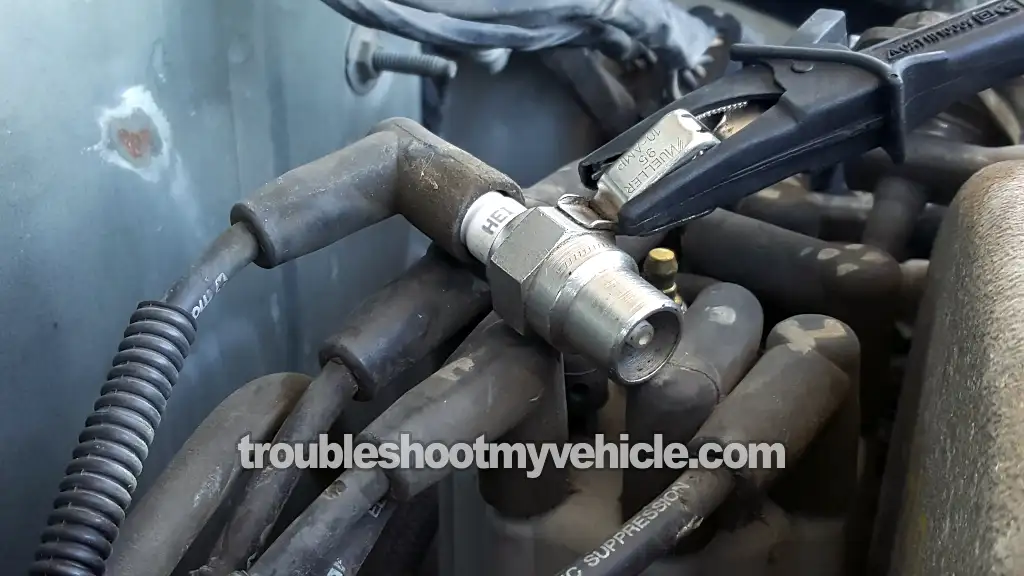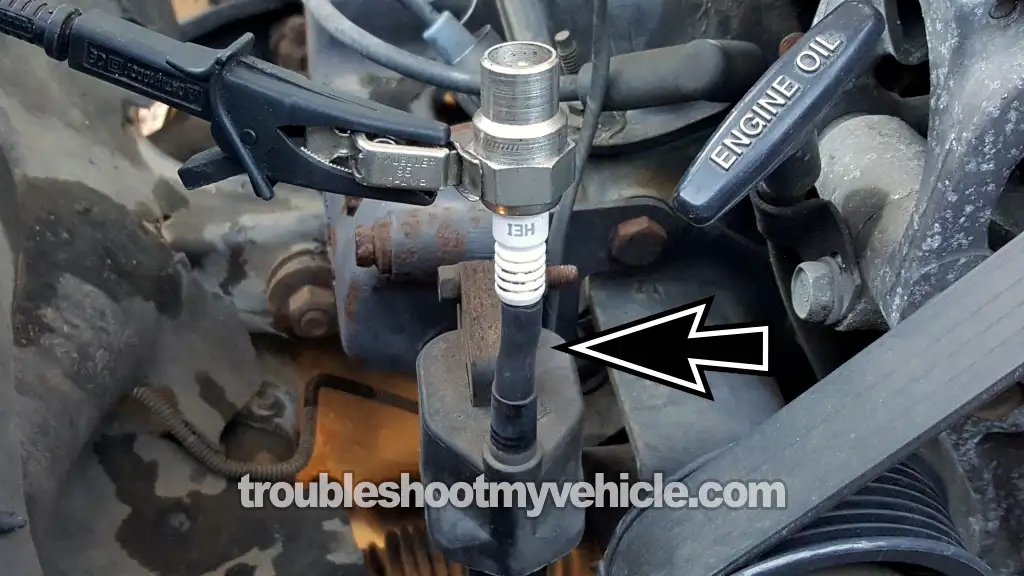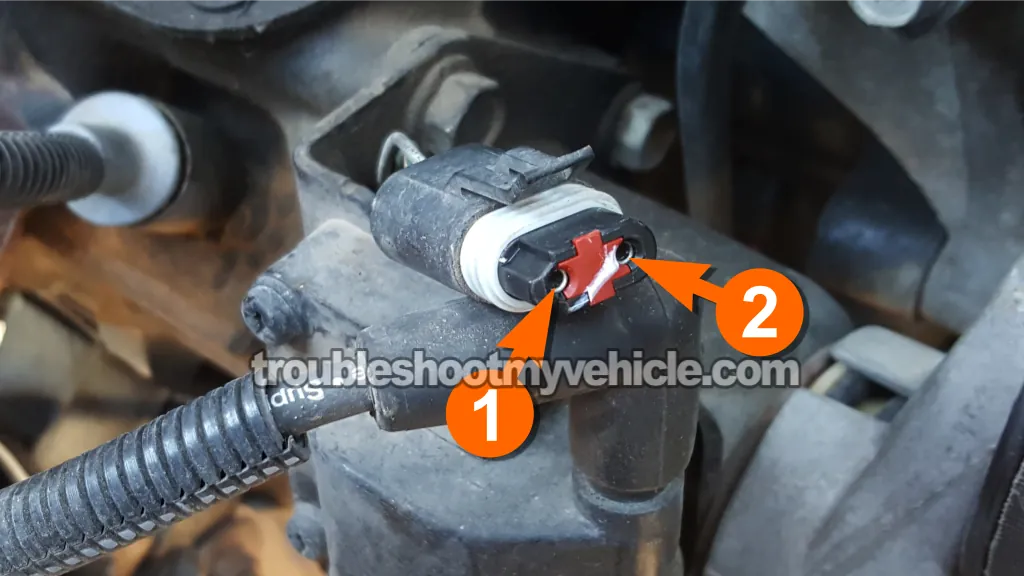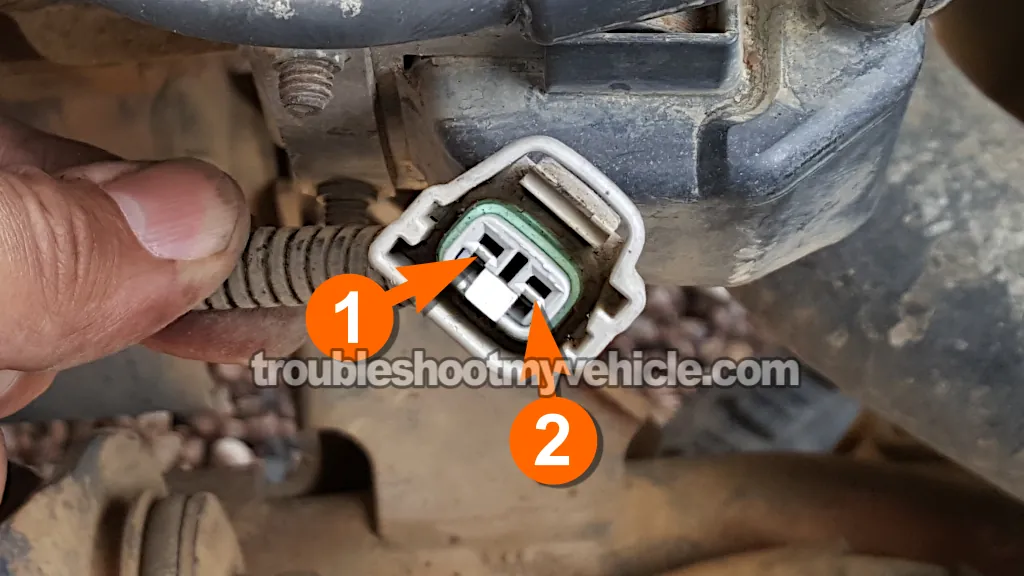TEST 3: Testing The Ignition Coil's High Tension Wire For Spark

So, if you're about to perform this test, then none of the six spark plug wires sparked in TEST 1.
There's a good possibility that the ignition coil's high-tension wire is bad and not delivering the spark from the ignition coil to the distributor cap.
To check for this very common type of failure, we're gonna test the ignition coil's high tension wire for spark with the spark tester.
Here's how to do it:
- 1
Unplug the high-tension wire from the center of the distributor cap.
NOTE: Keep the other end of that wire connected to the ignition coil. - 2
Attach your spark tester to the loose end of the wire —the one you just pulled off the cap (check the photo above for reference).
NOTE: Make sure the ignition coil end stays firmly plugged in. - 3
Ground the spark tester by connecting it to the battery's negative (-) post with a jumper cable.
- 4
Have someone crank the engine while you watch for spark.
- 5
You should see the spark tester spark away the whole time the engine's cranking.
Let's break down what the results tell you:
CASE 1: The spark tester fires spark. That's what we want to see.
That means the high tension wire (and the ignition coil) are working, and the engine no-start problem lies in the distributor cap or rotor —but only if both of these apply:
- Back in TEST 1, none of the plug wires were sparking.
- And now, you've confirmed spark is coming from the ignition coil wire.
To get your V6 Dodge Ram pickup running again, replace the spark plug wires with a fresh set.
It's not required, but if your spark plugs, cap, and rotor are old too, it's a good idea to replace them all at once.
CASE 2: The spark tester DID NOT spark. That means spark isn't reaching the distributor.
Your next step is to test the ignition coil for spark directly at its tower. Go to: TEST 4: Testing The Ignition Coil For Spark.
TEST 4: Testing The Ignition Coil For Spark

The previous tests have revealed quite a few important things:
- TEST 1: The spark plug wires aren't delivering spark.
- TEST 3: The high-tension wire, connecting the ignition coil to the distributor, isn't sparking either.
To continue troubleshooting this lack of spark, we'll check for spark directly at the ignition coil's tower —just like you see in the photo above.
Let's get to it:
- 1
Unplug the high-tension wire from the ignition coil.
- 2
Attach your spark tester directly to the ignition coil's tower using a small piece of vacuum hose (see the photo above for a visual).
NOTE: The arrow in the image points to the vacuum hose I'm using to hold the spark tester on the ignition coil's tower. - 3
Ground the tester by hooking it up to the battery's negative (-) terminal using a jumper cable.
- 4
Have your helper crank the engine while you keep a close eye on the tester.
- 5
The spark tester should spark as the engine cranks.
Here's what the results mean:
CASE 1: All good, the spark tester sparked. That's exactly what we want.
This proves the ignition coil itself is in good shape. If all of the following are true:
- None of the plug wires sparked during TEST 1,
- The ignition coil's high-tension wire didn't spark in TEST 3,
- But now you're getting spark directly from the ignition coil,
Then the issue is 100% that high-tension wire —it's bad. Replace it. The ideal solution here is to replace all of the spark plug wires with a new set.
CASE 2: Still no spark. Next step? We've gotta find out if the ignition coil is getting power.
Let's head over to: TEST 5: Making Sure The Ignition Coil Is Getting 12 Volts.
TEST 5: Making Sure The Ignition Coil Is Getting 12 Volts
The ignition coil gets 12 Volts from the Auto Shutdown (ASD) Relay. If this power isn't delivered to it, it won't fire spark at all.
The wire that supplies this voltage is the dark green with orange stripe (DK GRN/ORG) wire of the ignition coil's 2-wire connector, no matter which style connector your pickup uses.
In the photo above, I've marked the terminal that connects to the DK GRN/ORG wire with the number 1.
We'll use a multimeter to check for power at that terminal while the engine is cranking. You won't get a voltage reading unless the engine is turning over.
CAUTION: Since the engine needs to crank during this test, stay alert and take all necessary safety precautions around moving parts!
Here's how to check it:
- 1
Unplug the ignition coil from its 2-wire connector.
- 2
Attach the black test lead to the battery's negative (-) terminal.
- 3
Switch your multimeter to DC Volts mode.
- 4
Touch the red test lead to terminal 1 of the connector.
NOTE: Make sure that terminal actually corresponds with the DK GRN/ORG wire. - 5
Have your helper crank the engine while you keep an eye on the multimeter's display.
- 6
You should see a reading of 10 to 12 Volts on the screen.
Now, let's break down the results:
CASE 1: You're getting 10 to 12 Volts. That's exactly what we want —it confirms the ignition coil is getting proper power.
Since we're still chasing a no-spark, no-start situation, our next step is to see if the ignition coil is receiving its activation signal. Go to: TEST 6: Testing The Ignition Coil's Activation Signal.
CASE 2: No voltage at the terminal. That's a clear sign the ignition coil isn't getting power —so it can't fire spark.
This usually happens for one of two reasons:
- A break or fault in the wire running between the ignition coil's connector and the ASD (Auto Shutdown) relay.
- Either the CMP sensor or CKP sensor is bad.
Your next step is to check the CMP and CKP sensors.


